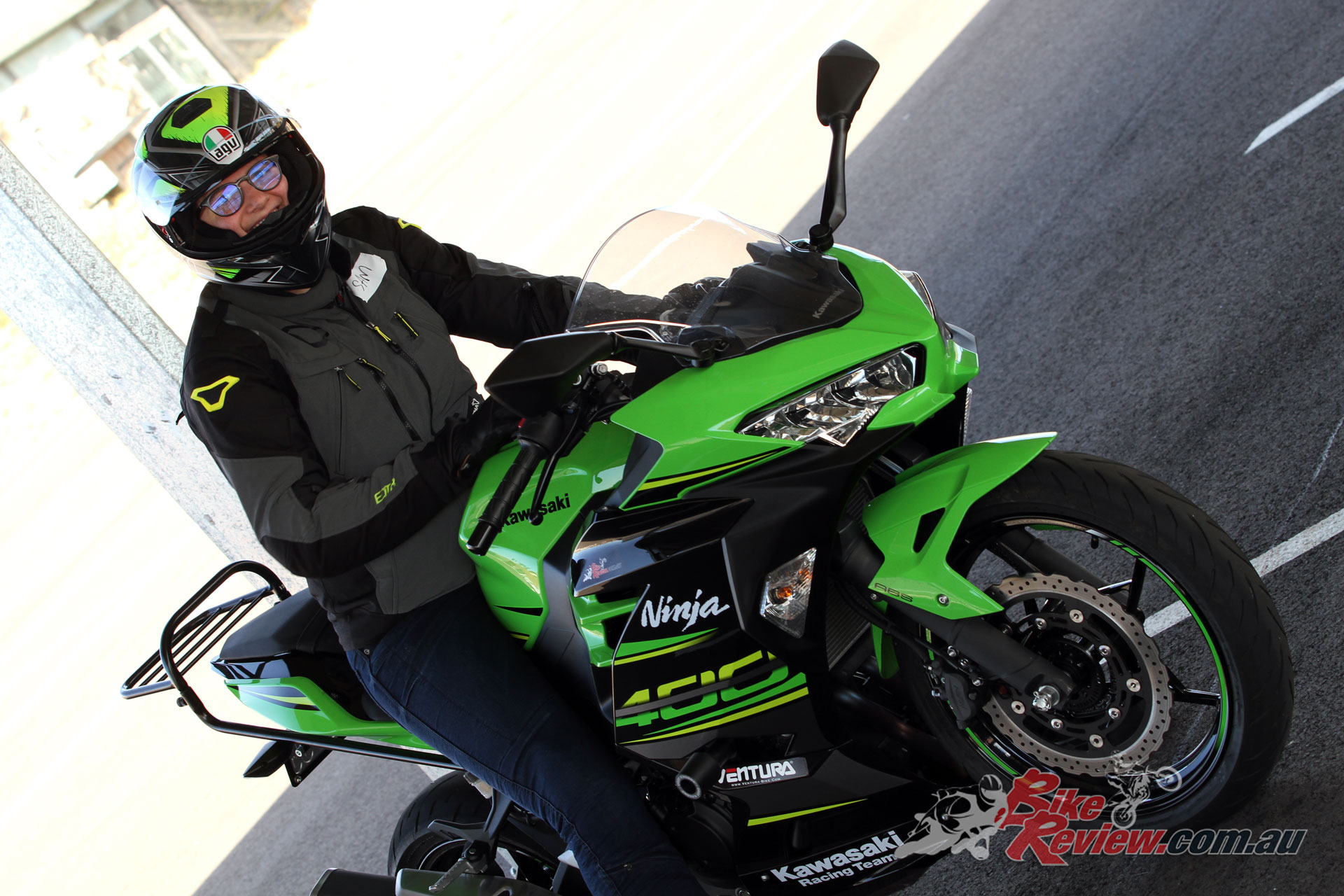Samantha gives a new motorcycle riders impression on our Long Term Ninja 400, having not ridden a bike with a clutch since doing her L's course a decade ago! Words: Samantha Kimber, Images by Kris Hodgson
My first reaction to the Kawasaki Ninja 400 as a ‘new’ motorcycle rider, with quite a few years of scooter riding experience under my belt was, ‘Wow that was easier than expected!’
For me, the Ninja is just what I needed to transition from a scooter to a motorcycle, and all the features that lend the bike to this transition will also make for a great first machine for any new rider.
It has been a decade since I have ridden a motorcycle during the L’s course when I went for my license and as an everyday commuter in heavy traffic a scooter at the time just made more sense in so many ways. Making the move to a motorcycle I needed something that was light-weight, easy to learn on and comfortable (essentially all the things that make scooters so appealing). So far, first impressions are that the Ninja 400 is all that and more.
In terms of style you can’t look past the iconic Kawasaki green and sporty lines. It stands out and has presence on the road, and as a scooter rider I find it hard to tell from the mid capacity machines, which seems to be something shared with those who ask me about the bike. A lot of people are surprised it’s 400cc and learner legal.
The seat height is just right for my 178cm frame which is really important for new and shorter riders, and I can easily reach the ground when I come to a stop. While the Ninja 400 to me feels heavier than my scooter when wheeling it around, I’ve been told the actual weights are very similar and it’s just scooter’s low centre of gravity which creates this feeling. The Ninja 400 does seem easy to handle either way, which is important when you’re not used to the weight.
The pegs aren’t too high either, so I don’t feel like I’m crouching (another important feature when you’re used to sitting like you’re on a chair on a scooter) and the Ninja 400 has an upright seating position which for me is perfect as it’s a bit like being on a scooter and means I don’t have to think too much about how I’m sitting or shifting my weight for riding. Compared to sitting on my partner’s sportsbike it’s very obvious the Ninja 400 looks like a sportsbike but doesn’t share that kind of seating position.
I found the seat very comfortable and I felt I sat close to the tank, which may probably just be me coming from a scooter, but this helps the feeling of balance and improves confidence when learning to corner. The seat is wide enough for comfort, while getting thin towards the tank, meaning your knees feel close together.
Additionally my reach to the handlebars was about right for my size as I don’t have to lean too far forward, so it’s nice and upright and I was naturally just looking down the road where I was going. I do find after a lengthy ride that my arms are tired.
The bike is fairly light in weight once you’re on the move, meaning it maneuvers easily particularly at low speeds, which is where I’ve been doing most of my practicing to get used to the bike. I also found the balance good, and as I gain more speed and confidence riding I should be able to properly take advantage of the Ninja 400’s performance even better.
I’m only using the lower part of the rev range at the moment, and it’s easy to release the clutch and get moving on the flat, although hill starts I still need to concentrate on, so the Ninja 400 is very forgiving when you’re getting used to the clutch. Braking is also fairly smooth, but I have found the engine braking a bit jumpy at first but that’s all me and will improve as I ride more.
I would absolutely recommend the Ninja 400 to new riders, and to those transitioning from a scooter to a motorcycle. To put it simply it makes me confident I won’t stuff up on the road.
You can check out our full 2018 Kawasaki Ninja 400 Road Test, and 2018 Kawasaki Ninja 400 Track Test, at these links.
2018 Kawasaki Ninja 400 Specifications
Price: From $7699 Ride Away
Warranty: Two-year, unlimited kilometre
Colours: Kawasaki Racing Green/Ebony, Metallic Spark Black/Ebony, Candy Burnt Orange/Metallic Magnetic Gray/Metallic Spark Black
Claimed power: 33.4kW [45hp] @ 10000RPM
Claimed torque: 38Nm [28ft-lbs] @ 8000RPM
Dry weight: 168kg
Fuel capacity: 14L
Engine: Liquid cooled, parallel twin-cylinder, four-stroke, 8-valve, DOHC, 399cc, 11.5:1 compression ratio, 70.0 x 51.8mm bore and stroke, single injector per cylinder
Gearbox: Six speed, constant mesh
Clutch: Wet, multi-plate with dual action slipper clutch, cable actuation
Chassis: High-tensile steel tube trellis frame with engine as fully stressed member, box-section steel swingarm, Rake: 24.7°, Trail: 92mm
Suspension: 41mm fork, 120mm travel, Unitrack gas-charged rear shock absorber, preload adjustable, 130mm travel
Brakes: Single Nissin 310mm semi-floating front disc, two-piston caliper, Nissin 220mm rear disc, two-piston caliper. Nissin ABS
Wheels & Tyres: Aluminium alloy, 110/70 – 17 (ff), 150/60 – 17 (rr)
Dimensions:
Wheelbase: 1370mm
Seat height: 785mm
Overall length: 1990mm
Overall width: 710mm
Instruments: Analogue tachometer, LCD speedometer, gear position indicator and multifunction display























